1000+ Anatomy of flowering plant Multiple Choice Question Answer [Solved]
Thursday 9th of March 2023

Sharing is caring
1. A common structural feature of vessel elements and sieve tube elements are
A. pores on lateral walls.
B. presence of p-protein.
C. enucleate condition.
D. thick secondary walls.
Answer : C
A. pores on lateral walls.
B. presence of p-protein.
C. enucleate condition.
D. thick secondary walls.
Answer : C
2. In stems, the protoxylem lies towards the _____________ and the metaxylem lies towards the ____________ of the organ.
A. centre; periphery
B. periphery; centre
C. periphery; periphery
D. centre; centre
Answer : A
A. centre; periphery
B. periphery; centre
C. periphery; periphery
D. centre; centre
Answer : A
3. Trees at sea do not have annual rings because
A. soil is sandy.
B. there is climatic variation.
C. there is no marked climatic variation.
D. there is enough moisture in the atmosphere.
Answer : C
A. soil is sandy.
B. there is climatic variation.
C. there is no marked climatic variation.
D. there is enough moisture in the atmosphere.
Answer : C
4. Match column-I with column-II and choose the correct option.
Which of the following combination is correct ?
A. A II, IV, VII, VIII; B I, III, V, VI
B. A I, II, VII, VIII; B III, IV, V, VI
C. A I, III, V, VI; B II, IV, VII, VIII
D. A I, III, VII, VIII; B II, IV, V, VI
Answer : C
| A. Spring wood or | I. Lighter in colour early wood |
|---|---|
| B. Autumn wood or | II. High density late wood |
| .. | III. Low density |
| .. | IV. Darker in colour |
| .. | V. Larger number of xylem elements |
| .. | VI. Vessels with wider cavity |
| .. | VII. Lesser number of xylem elements |
| .. | VIII. Vessels with small cavity |
Which of the following combination is correct ?
A. A II, IV, VII, VIII; B I, III, V, VI
B. A I, II, VII, VIII; B III, IV, V, VI
C. A I, III, V, VI; B II, IV, VII, VIII
D. A I, III, VII, VIII; B II, IV, V, VI
Answer : C
5. Xylem functions as a conducting tissue for water and minerals from _________to the ______and__________.
A. roots, stems, leaves
B. stems, roots, leaves
C. leaves, stems, roots
D. leaves, stems, leaves
Answer : A
A. roots, stems, leaves
B. stems, roots, leaves
C. leaves, stems, roots
D. leaves, stems, leaves
Answer : A
6. Which one of the following have vessels as their characteristic feature?
A. Angiosperms
B. Gymnosperms
C. Pteridophytes
D. Bryophytes
Answer : A
A. Angiosperms
B. Gymnosperms
C. Pteridophytes
D. Bryophytes
Answer : A
7. Sieve tubes are suited for translocation of food because they possess
A. bordered pits.
B. no ends walls.
C. broader lumen and perforated cross walls.
D. no protoplasm.
Answer : C
A. bordered pits.
B. no ends walls.
C. broader lumen and perforated cross walls.
D. no protoplasm.
Answer : C
8. A plant tissue when stained showed the presence of hemicellulose and pectin in cells wall of its cells. The tissue is called
A. collenchyma
B. sclerenchyma
C. xylem
D. meristem
Answer : A
A. collenchyma
B. sclerenchyma
C. xylem
D. meristem
Answer : A
9. T.S. of dicot leaf passing through the midrib is given below. Certain parts have been marked by alphabets (A to H). Choose the option showing their correct labelling.

A. A Epidermis, B Spongy mesophyll, C Palisade mesophyll, D Stomata, E Guard cells, F Phloem, G Metaxylem, H Protoxylem
B. A Epidermis, B Palisade mesophyll, C Spongy mesophyll, D Sub-stomatal cavity, E Stoma, F Phloem, G Xylem, H Bundle sheath
C. A Epidermis, B Palisade mesophyll, C Spongy mesophyll, D Stomata, E Guard cells, F Epidermis, G Xylem, H Phloem
D. A Epidermis, C Palisade mesophyll, C Spongy mesophyll, D Stomata, E Guard cells, F Phloem, G Metaxylem, H Protoxylem
Answer : B

A. A Epidermis, B Spongy mesophyll, C Palisade mesophyll, D Stomata, E Guard cells, F Phloem, G Metaxylem, H Protoxylem
B. A Epidermis, B Palisade mesophyll, C Spongy mesophyll, D Sub-stomatal cavity, E Stoma, F Phloem, G Xylem, H Bundle sheath
C. A Epidermis, B Palisade mesophyll, C Spongy mesophyll, D Stomata, E Guard cells, F Epidermis, G Xylem, H Phloem
D. A Epidermis, C Palisade mesophyll, C Spongy mesophyll, D Stomata, E Guard cells, F Phloem, G Metaxylem, H Protoxylem
Answer : B
10. The given figures are types of elements (A and B) which constitute one type of complex tissue (c) of a plant . Identify A, B and C.
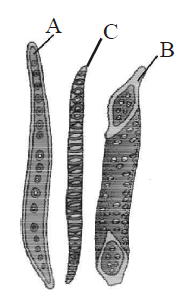
A. A Tracheid, B Vessel, C Xylem
B. A Vessel, B Tracheild, C Phloem
C. A Fibre, B Tracheid, C Bark
D. A Fibre, B Sclereid, C Casparian strips
Answer : A

A. A Tracheid, B Vessel, C Xylem
B. A Vessel, B Tracheild, C Phloem
C. A Fibre, B Tracheid, C Bark
D. A Fibre, B Sclereid, C Casparian strips
Answer : A
11. In an experiment, a student cut a transverse section of young stem of a plant which he has taken from his school garden.
After observing it under the microscope how would he ascertain whether it is a monocot stem or a dicot stem?
A. With the help of bulliform cells.
B. With the help of casparian strips.
C. With the help of vascular bundles.
D. With the help of stomatal apparatus.
Answer : C
After observing it under the microscope how would he ascertain whether it is a monocot stem or a dicot stem?
A. With the help of bulliform cells.
B. With the help of casparian strips.
C. With the help of vascular bundles.
D. With the help of stomatal apparatus.
Answer : C
12. During the formation of leaves and elongation of stem, some cells left behind from the shoot apical meristem, constitute the
A. lateral meristem
B. axillary bud
C. cork cambium
D. fascicular cambium
Answer : B
A. lateral meristem
B. axillary bud
C. cork cambium
D. fascicular cambium
Answer : B
13. The given figure shows apical meristem of root apex with few part marked as A, B and C. Identify the correct labelling of A, B and C.
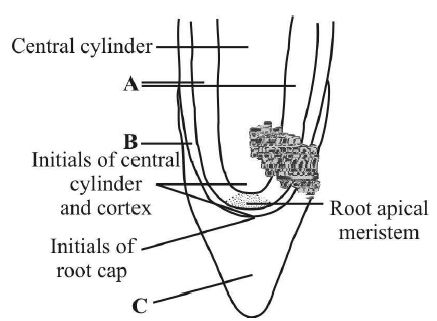
A. A Vascular structure, B Protoderm, C Root cap
B. A Cortex, B Endodermis, C Root cap
C. A Cortex, B Protoderm, C Root cap
D. A Tunica, B Protoderm, C Root cap
Answer : C

A. A Vascular structure, B Protoderm, C Root cap
B. A Cortex, B Endodermis, C Root cap
C. A Cortex, B Protoderm, C Root cap
D. A Tunica, B Protoderm, C Root cap
Answer : C
14. T.S. of dicot stem is given below, certain parts have been marked by alphabets (A I). Choose the option which shows their correct labelling.

A. A Epidermis, B Epidermal hair, C Parenchyma, D Starch sheath, E Hypodermis (collenchyma), F Vascular bundle, G Bundle cap, H Medulla or pith, I Medullary rays
B. A Epidermal hair, B Epidermis, C Hypodermis (collenchyma), D Parenchyma, E Endoderm is (Starch Sheath), F Pericycle, G Vascular bundle, H Medullary rays, I Medulla or pith
C. A Epidermal hair, B Epidermis, C Hypodermis (collenchyma), D Starch sheath, E Parenchyma, F Vascular bundle, G Bundle cap, H Medulla or pith, I Medullary rays
D. A Epidermal hair, B Epidermis, C Parenchyma, D Hypodermis (collenchyma), E Starch sheath, F Vascular bundle, G Bundle cap, H Medulla or pith, Medullary rays
Answer : B

A. A Epidermis, B Epidermal hair, C Parenchyma, D Starch sheath, E Hypodermis (collenchyma), F Vascular bundle, G Bundle cap, H Medulla or pith, I Medullary rays
B. A Epidermal hair, B Epidermis, C Hypodermis (collenchyma), D Parenchyma, E Endoderm is (Starch Sheath), F Pericycle, G Vascular bundle, H Medullary rays, I Medulla or pith
C. A Epidermal hair, B Epidermis, C Hypodermis (collenchyma), D Starch sheath, E Parenchyma, F Vascular bundle, G Bundle cap, H Medulla or pith, I Medullary rays
D. A Epidermal hair, B Epidermis, C Parenchyma, D Hypodermis (collenchyma), E Starch sheath, F Vascular bundle, G Bundle cap, H Medulla or pith, Medullary rays
Answer : B
15. Identify A, B and C in the given figure of shoot apical meristem
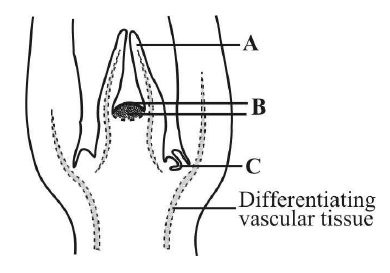
A. A Leaf primordium, B Shoot apical meristem, C Axillary bud
B. A Leaf primordium, B Shoot apical meristem, C Apical bud
C. A Root hair primordium, B Root apical meristem, C Axillary bud
D. A Root hair primordium, B Root apical meristem, C Terminal bud
Answer : A

A. A Leaf primordium, B Shoot apical meristem, C Axillary bud
B. A Leaf primordium, B Shoot apical meristem, C Apical bud
C. A Root hair primordium, B Root apical meristem, C Axillary bud
D. A Root hair primordium, B Root apical meristem, C Terminal bud
Answer : A
16. Some vascular bundles are described as open because these
A. are surrounded by pericycle but not endodermis.
B. are capable of producing secondary xylem and phloem.
C. possess conjunctive tissue between xylem and phloem.
D. are not surrounded by pericycle.
Answer : B
A. are surrounded by pericycle but not endodermis.
B. are capable of producing secondary xylem and phloem.
C. possess conjunctive tissue between xylem and phloem.
D. are not surrounded by pericycle.
Answer : B
17. Which of the following figure is a type of permanent tissue having many different types of cell?
A.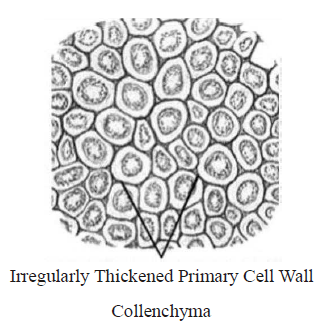
B.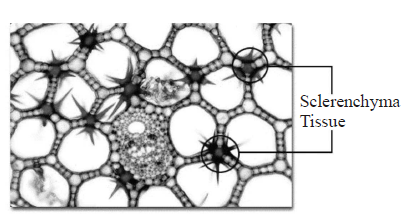
C.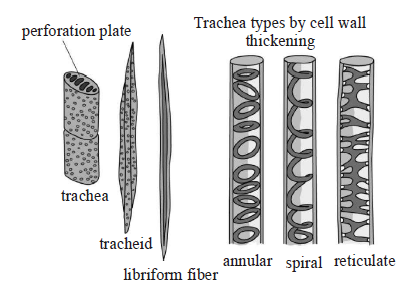
D.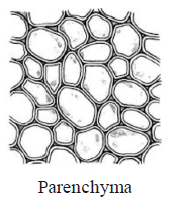
Answer : C
A.

B.

C.

D.

Answer : C
18. Cork is formed from
A. phellogen
B. vascular cambium
C. phloem
D. xylem
Answer : A
A. phellogen
B. vascular cambium
C. phloem
D. xylem
Answer : A
19. Match the names of the structures given in column-I with the functions given in column-II, choose the answer which gives the correct combination of the two columns :
A. A V, B III, C I, D IV
B. A I, B IV, C V, D III
C. A II, B IV, C I, D III
D. A IV, B I, C III, D V
Answer : D
| Column-I | Column-II |
|---|---|
| (Structure) | (Function) |
| A. Stomata | I. Protection of stem |
| B. Bark | II. Plant movement |
| C. Cambium | III. Secondary growth |
| D. Cuticle | IV. Transpiration |
| V. Prevent the loss of water | ... |
A. A V, B III, C I, D IV
B. A I, B IV, C V, D III
C. A II, B IV, C I, D III
D. A IV, B I, C III, D V
Answer : D
20. The apical meristem of the root is present
A. in all the roots.
B. only in radicals.
C. only in tap roots.
D. only in adventitious roots.
Answer : A
A. in all the roots.
B. only in radicals.
C. only in tap roots.
D. only in adventitious roots.
Answer : A
21. Cork cambium and vascular cambium are
A. the parts of secondary xylem and phloem.
B. the parts of pericycle.
C. lateral meristems.
D. apical meristems.
Answer : C
A. the parts of secondary xylem and phloem.
B. the parts of pericycle.
C. lateral meristems.
D. apical meristems.
Answer : C
22. The length of different internodes in a culm of sugarcane is variable because of
A. size of leaf lamina at the node below each internode
B. intercalary meristem
C. shoot apical meristem
D. position of axillary buds
Answer : B
A. size of leaf lamina at the node below each internode
B. intercalary meristem
C. shoot apical meristem
D. position of axillary buds
Answer : B
23. Read the following statements and answer the question.
Which type of wood is described by the above statements?
A. Sap wood
B. Heart wood
C. Spring wood
D. Autumn wood
Answer : C
- Cambium is very active and produces a large number of xylary elements having vessels with wider cavities.
- It is also called early wood.
- It is lighter in colour and has lower density.
Which type of wood is described by the above statements?
A. Sap wood
B. Heart wood
C. Spring wood
D. Autumn wood
Answer : C
24. Which meristem helps in increasing girth?
A. Lateral meristem
B. Intercalary meristem
C. Primary meristem
D. Apical meristem
Answer : A
A. Lateral meristem
B. Intercalary meristem
C. Primary meristem
D. Apical meristem
Answer : A
25. Choose the correct labelling of (A J) in the given figure of T.S. of monocot root.

A. A Root hair, B Epiblema, C Cortex, D Endodermis, E Passage cell, F Pericycle, G Pith, H Phloem, I Metaxylem.
B. A Root hair, B Epiblema, C Cortex, D Endodermis, E Passage cell, F Pith, G Pericycle, H Metaxylem, I Phloem.
C. A Root hair, B Epiblema, C Cortex, D Endodermis, E Pericycle, F Phloem, G Protoxylem, I Metaxylem
D. A Root hair, B Cortex, C Epiblema, D Pericycle, E Endodermis, F Pith, G Phloem, H Protoxylem, I Metaxylem
Answer : C

A. A Root hair, B Epiblema, C Cortex, D Endodermis, E Passage cell, F Pericycle, G Pith, H Phloem, I Metaxylem.
B. A Root hair, B Epiblema, C Cortex, D Endodermis, E Passage cell, F Pith, G Pericycle, H Metaxylem, I Phloem.
C. A Root hair, B Epiblema, C Cortex, D Endodermis, E Pericycle, F Phloem, G Protoxylem, I Metaxylem
D. A Root hair, B Cortex, C Epiblema, D Pericycle, E Endodermis, F Pith, G Phloem, H Protoxylem, I Metaxylem
Answer : C
26. Match the followings and choose the correct option
A. A III, B IV, C I, D II
B. A I, B II, C III, D IV
C. A III, B II, C IV, D I
D. A III, B II, C I, D IV
Answer : A
| Column-I | Column-II |
|---|---|
| A. Cuticle | I. Guard cells |
| B. Bulliform cells | II. Outer layer |
| C. Stomata | III. Waxy layer |
| D. Epidermis | IV. Empty colourless cell |
A. A III, B IV, C I, D II
B. A I, B II, C III, D IV
C. A III, B II, C IV, D I
D. A III, B II, C I, D IV
Answer : A
27. An organised and differentiated cellular structure having cytoplasm but no nucleus is called _________.
A. vessels
B. xylem parenchyma
C. sieve tubes
D. tracheids
Answer : C
A. vessels
B. xylem parenchyma
C. sieve tubes
D. tracheids
Answer : C
28. Why grafting is successful in dicots ?
A. In dicots vascular bundles are arranged in a ring.
B. Dicots have cambium for secondary growth.
C. In dicots vessels with elements are arranged end to end.
D. Cork cambium is present in dicots
Answer : B
A. In dicots vascular bundles are arranged in a ring.
B. Dicots have cambium for secondary growth.
C. In dicots vessels with elements are arranged end to end.
D. Cork cambium is present in dicots
Answer : B
29. Bast fibres are made up of _____________cells.
A. sclerenchymatous
B. chlorenchymatous
C. parenchymatous
D. aerenchymatous
Answer : A
A. sclerenchymatous
B. chlorenchymatous
C. parenchymatous
D. aerenchymatous
Answer : A
30. The given figure shows T.S. of monocot stem. Identify the correct labelling of A to F marked in the given figure.
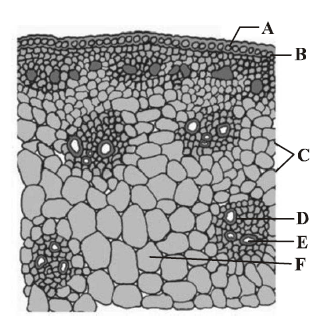
A. A Epidermis, B Hypodermis, C Vascular bundles, D Phloem, E Xylem, F Ground tissue
B. A Cuticle, B Epidermis, C Sclerenchymatous sheath, D Sclerenchymatous hypodermis, E Parenchymatous sheath, F Phloem
C. A Cuticle, B Epidermis, C Sclerenchymatous hypodermis, D Sclerenchymatous sheath, E Parenchymatous sheath, F Phloem
D. A Cuticle, B Epidermis, C Sclerenchymatous hypodermis, D Sclerenchymatous sheath, E Parenchymatous sheath, F Protoxylem
Answer : A

A. A Epidermis, B Hypodermis, C Vascular bundles, D Phloem, E Xylem, F Ground tissue
B. A Cuticle, B Epidermis, C Sclerenchymatous sheath, D Sclerenchymatous hypodermis, E Parenchymatous sheath, F Phloem
C. A Cuticle, B Epidermis, C Sclerenchymatous hypodermis, D Sclerenchymatous sheath, E Parenchymatous sheath, F Phloem
D. A Cuticle, B Epidermis, C Sclerenchymatous hypodermis, D Sclerenchymatous sheath, E Parenchymatous sheath, F Protoxylem
Answer : A
31. Main function of lenticel is
A. transpiration
B. guttation
C. gaseous exchange
D. both (a) & (c)
Answer : A
A. transpiration
B. guttation
C. gaseous exchange
D. both (a) & (c)
Answer : A
32. As secondary growth proceeds, in a dicot stem, the thickness of
A. sapwood increases.
B. heartwood increase.
C. both sapwood and heartwood increases.
D. both sapwood and heartwood remains the same.
Answer : C
A. sapwood increases.
B. heartwood increase.
C. both sapwood and heartwood increases.
D. both sapwood and heartwood remains the same.
Answer : C
33. Apical and intercalary meristems are primary meristems because
A. they occur in the mature region of roots and shoots of many plants.
B. they made up of different kinds of tissues.
C. they involved in secondary growth.
D. they appear early in life of a plant and contribute to the formation of the primary plant body.
Answer : D
A. they occur in the mature region of roots and shoots of many plants.
B. they made up of different kinds of tissues.
C. they involved in secondary growth.
D. they appear early in life of a plant and contribute to the formation of the primary plant body.
Answer : D
34. Identify the types of simple tissue indicated by A, B, C and D and their function.
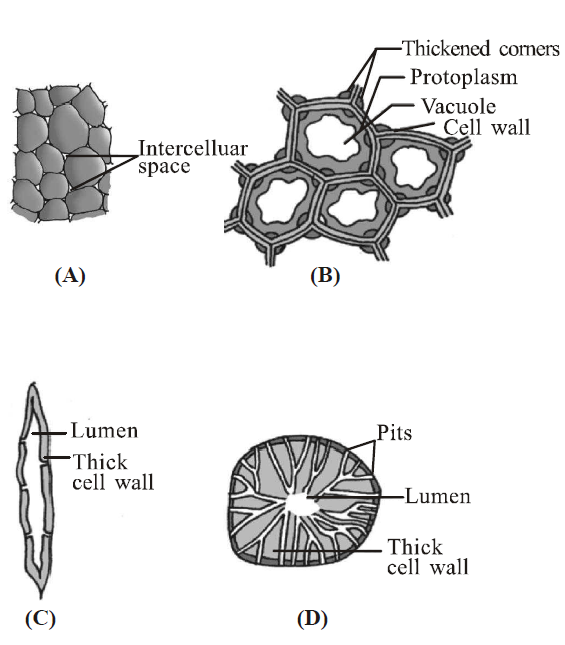
A. A Parenchyma, Photosynthesis, Storage and Secretion.
B. B Sclerenchyma Scleriods; Transport food material
C. C Collenchyma; Provides mechanical support to organs.
D. D Sclerenchyma Fibres; Provide Mechanical support to the growing parts of the plant such as young stem and petiole of a leaf.
Answer : A

A. A Parenchyma, Photosynthesis, Storage and Secretion.
B. B Sclerenchyma Scleriods; Transport food material
C. C Collenchyma; Provides mechanical support to organs.
D. D Sclerenchyma Fibres; Provide Mechanical support to the growing parts of the plant such as young stem and petiole of a leaf.
Answer : A
35. Which of the following process helps the trichomes in preventing water loss?
A. Where companion cells helps in maintaining the pressure gradient in the sieve tubes.
B. Where plants absorb water through the roots and then give off water vapor through pores in their leaves.
C. Where activity of cork cambium builds pressure on the remaining layers peripheral to phellogen and ultimately these layers dies and slough off.
D. None of the above
Answer : B
A. Where companion cells helps in maintaining the pressure gradient in the sieve tubes.
B. Where plants absorb water through the roots and then give off water vapor through pores in their leaves.
C. Where activity of cork cambium builds pressure on the remaining layers peripheral to phellogen and ultimately these layers dies and slough off.
D. None of the above
Answer : B
36. Read the following statements and answer the question.
Which plant anatomy is being described by the above statements?
A. Dicotyledonous root
B. Monocotyledonous root
C. Dicotyledonous stem
D. Monocotyledonous stem
Answer : D
- It has a sclerenchymatous hypodermis, a large number of scattered vascular bundles and a large parenchymatous ground tissue.
- Vascular bundles are conjoint and closed.
- Peripheral vascular bundles are generally smaller than the centrally located ones.
- Phloem parenchyma is absent, and water- containing cavities are present within the vascular bundles.
Which plant anatomy is being described by the above statements?
A. Dicotyledonous root
B. Monocotyledonous root
C. Dicotyledonous stem
D. Monocotyledonous stem
Answer : D
37. Which of the following statement(s) is/are not correct?
A. (iii) and (iv)
B. (i) and (ii)
C. (ii) and (iii)
D. (ii) and (iv)
Answer : A
- Cork cambium is also called phellogen.
- Cork is also called phellem.
- Secondary cortex is also called periderm.
- Cork cambium, cork and secondary cortex are collectively called phelloderm.
A. (iii) and (iv)
B. (i) and (ii)
C. (ii) and (iii)
D. (ii) and (iv)
Answer : A
38. Match column-I with column-II and choose the correct option.
A. A III, B V, C IV, D I, E II
B. A II, B V, C I, D III, E IV
C. A II, B IV, C I, D III, E V
D. A III, B I, C V, D II, E IV
Answer : D
| Column -I | Column -II |
|---|---|
| A. Bulliform cells | I. Initiation of lateral roots |
| B. Pericycle | II. Root |
| C. Endarch xylem | III. Grasses |
| D. Exarch xylem | IV. Dicot leaf |
| E. Bundle sheath cells | V. Stem |
A. A III, B V, C IV, D I, E II
B. A II, B V, C I, D III, E IV
C. A II, B IV, C I, D III, E V
D. A III, B I, C V, D II, E IV
Answer : D
39. A piece of wood having no vessels (trachea) must be belonged to
A. teak
B. mango
C. pine
D. palm
Answer : C
A. teak
B. mango
C. pine
D. palm
Answer : C
40. The given figure shows the secondary growth in a dicot stem. Their parts are marked as A, B, C, D, E & F. Choose the correct labelling of the parts marked as A to F.

A. A Phellem, B Phellogen, C Medullary rays, D Secondary xylem, E Secondary phloem, F Cambium ring
B. A Phellem, B Phellogen, C Medullary rays, D Secondary phloem, E Secondary xylem, F Cambium ring
C. A Phellogen, B Phellem, C Medullary rays, D Secondary xylem, E Secondary phloem, F Cambium ring
D. A Phellem, B Phellogen, C Cambium ring, D Secondary xylem, E Secondary phloem, F Medullary rays
Answer : A

A. A Phellem, B Phellogen, C Medullary rays, D Secondary xylem, E Secondary phloem, F Cambium ring
B. A Phellem, B Phellogen, C Medullary rays, D Secondary phloem, E Secondary xylem, F Cambium ring
C. A Phellogen, B Phellem, C Medullary rays, D Secondary xylem, E Secondary phloem, F Cambium ring
D. A Phellem, B Phellogen, C Cambium ring, D Secondary xylem, E Secondary phloem, F Medullary rays
Answer : A
41. In the given columns, column I contain structures of female reproductive system and column II contain its feature. Select the correct match.
A. A - (i), B - (ii), C - (iii), D - (iv)
B. A - (iii), B - (i), C - (ii), D - (iv)
C. A - (i), B - (iv), C - (iii), D - (ii)
D. A - (ii), B - (iv), C - (iii), D - (i)
Answer : A
| Column-I | Column-II |
|---|---|
| A. Lateral meristem | (i) Fascicular vascular cambium, interfascicular cambium and cork cambium. |
| B. Apical meristem | (ii) Produces dermal tissue, ground tissues and vascular tissue. |
| C. Bast fibres | (iii) Generally absent in primary phloem but found in secondary phloem. |
| D. Sap wood | (iv) Involved in the conduction of water and minerals from the root to leaf. |
A. A - (i), B - (ii), C - (iii), D - (iv)
B. A - (iii), B - (i), C - (ii), D - (iv)
C. A - (i), B - (iv), C - (iii), D - (ii)
D. A - (ii), B - (iv), C - (iii), D - (i)
Answer : A
42. Tissues are classified into two main groups, namely meristematic and permanent tissues on the basis of
A. whether the cells being able to divide or not.
B. position of the cells.
C. whether they are living or dead.
D. none of the above
Answer : A
A. whether the cells being able to divide or not.
B. position of the cells.
C. whether they are living or dead.
D. none of the above
Answer : A
43. Cambium is considered as a lateral meristem because
A. it gives rise to lateral branches.
B. it causes increasein girth.
C. it increases height and diameter of a plant.
D. it adds bulk to a plant.
Answer : B
A. it gives rise to lateral branches.
B. it causes increasein girth.
C. it increases height and diameter of a plant.
D. it adds bulk to a plant.
Answer : B
44. A vascular bundle in which the protoxylem is pointing to the periphery is called __________.
A. endarch
B. exarch
C. radial
D. closed
Answer : B
A. endarch
B. exarch
C. radial
D. closed
Answer : B
45. The vessel elements of angiosperms differ from other elements of xylem in having
A. simple pits on their radial walls.
B. bordered pits on their lateral walls.
C. simple and bordered pits on their end walls.
D. simple perforation on their end walls.
Answer : D
A. simple pits on their radial walls.
B. bordered pits on their lateral walls.
C. simple and bordered pits on their end walls.
D. simple perforation on their end walls.
Answer : D
46. T.S. of monocot leaf is given below, certain parts have been marked by alphabets (A G). Which one is the option showing there correct labelling?
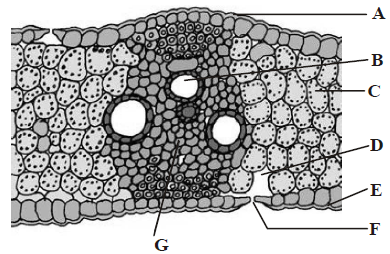
A. A Adaxial epidermis, B Xylem, C Mesophyll, D Sub-stomatal cavity, E Abaxial epidermis, F Stoma, G Phloem
B. A Adaxial epidermis, B Abaxial epidermis, C Xylem, D Sub-stomatal cavity, E Stoma, F Mesophyll, G Phloem
C. A Adaxial epidermis, B Phloem, C Mesophyll, D Sub-stomatal cavity, E Abaxial epidermis, F Xylem, G Stoma
D. A Adaxial epidermis, B Xylem, C Stoma, D Substomatal cavity, E Abaxial epidermis, F Phloem, G Mesophyll
Answer : A

A. A Adaxial epidermis, B Xylem, C Mesophyll, D Sub-stomatal cavity, E Abaxial epidermis, F Stoma, G Phloem
B. A Adaxial epidermis, B Abaxial epidermis, C Xylem, D Sub-stomatal cavity, E Stoma, F Mesophyll, G Phloem
C. A Adaxial epidermis, B Phloem, C Mesophyll, D Sub-stomatal cavity, E Abaxial epidermis, F Xylem, G Stoma
D. A Adaxial epidermis, B Xylem, C Stoma, D Substomatal cavity, E Abaxial epidermis, F Phloem, G Mesophyll
Answer : A
47. Gymnosperms are also called soft wood spermatophytes because they lack
A. cambium
B. phloem fibres
C. thick-walled tracheids
D. xylem fibres
Answer : D
A. cambium
B. phloem fibres
C. thick-walled tracheids
D. xylem fibres
Answer : D
48. Which one of the followings option shows the correct labelling of the parts marked as A, B, C and D in the given figure a lenticel?
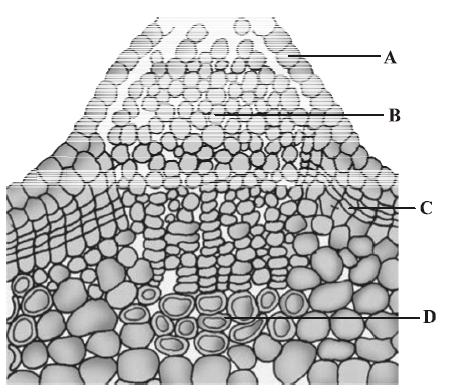
A. A Epidermis, B Secondary cortex, C Cork cambium, D Cork
B. A Pore, B Cork cambium, C Secondary cortex, D Cork
C. A Pore, B Cork, C Complimentary cells, D Cork cambium
D. A Epidermis, B Complimentary cells, C Cork cambium, D Secondary cortex
Answer : D

A. A Epidermis, B Secondary cortex, C Cork cambium, D Cork
B. A Pore, B Cork cambium, C Secondary cortex, D Cork
C. A Pore, B Cork, C Complimentary cells, D Cork cambium
D. A Epidermis, B Complimentary cells, C Cork cambium, D Secondary cortex
Answer : D
49. Which one of the following option shows the correct labelling of the parts marked as A, B, C and D in the given figure of a typical dicot root?
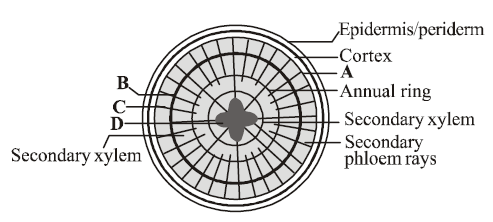
A. A Primary phloem, B Vascular cambium, C Secondary phloem, D Primary xylem
B. A Secondary phloem, B Vascular cambium, C Primary phloem, D Primary xylem
C. A Primary phloem, B Primary xylem, C Secondary phloem, D Vascular cambium
D. A Secondary phloem, B Primary xylem, C Primary phloem, D Vascular cambium
Answer : A

A. A Primary phloem, B Vascular cambium, C Secondary phloem, D Primary xylem
B. A Secondary phloem, B Vascular cambium, C Primary phloem, D Primary xylem
C. A Primary phloem, B Primary xylem, C Secondary phloem, D Vascular cambium
D. A Secondary phloem, B Primary xylem, C Primary phloem, D Vascular cambium
Answer : A
50. Cells of permanent tissues are specialized
A. functionally.
B. only structurally.
C. both structurally and functionally.
D. for mitosis.
Answer : C
A. functionally.
B. only structurally.
C. both structurally and functionally.
D. for mitosis.
Answer : C
Sharing is caring
Related Post
1000+ English Grammer MCQ for NDA [Solved]
1000+ C Programming Multiple Choice Question Answer [Solved]
SSC Scientific Assistant - General Physics 1000+ MCQ [Solved] PDF Download
1000+ Operating System MCQ for LIC ADO [Solved]
Computer Fundamental 1000+ MCQ with answer for CLAT PG
1000+ Computer Fundamental Multiple Choice Question Answer [Solved]